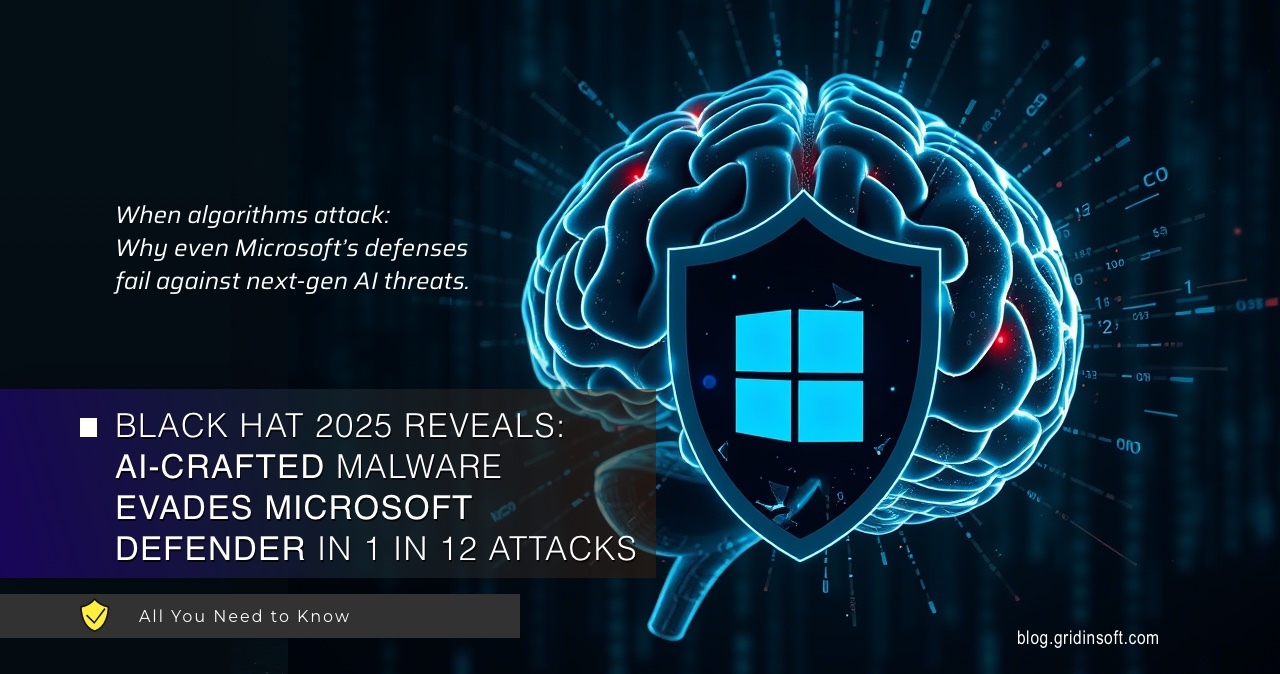Imagine a world where hackers don’t painstakingly craft malicious code by hand, but instead train AI models to evolve and outsmart antivirus software like living organisms. This isn’t science fiction—it’s the chilling reality unveiled in a groundbreaking proof-of-concept (PoC) by Kyle Avery, Principal Offensive Specialist Lead at Outflank 1.
- Background: From Hype to Reality in AI Malware
- The PoC Unveiled: Model and Core Mechanics
- Training Details: A Step-by-Step Breakdown
- The 8% Success Rate: Small Number, Big Implications
- Should You Panic? Not Yet
- Countermeasures: Fighting Back Against AI Evasion
- The Bigger Picture: AI vs AI Arms Race
- What This Means for Regular Users
- Implications: The Future of “Vibe Hacking”
- Looking Ahead: Preparing for the AI Era
- Stay Vigilant in the AI Era
Set to be presented at Black Hat USA 2025 in Las Vegas, this PoC demonstrates how reinforcement learning (RL) can turn an open-source language model into a malware-generating machine that reliably bypasses Microsoft Defender for Endpoint. What makes this research so intriguing? It’s not just about evasion—it’s about democratizing advanced hacking.
With a modest budget of around $1,500 and three months of training on consumer hardware, Avery created a tool that succeeds 8% of the time, meaning attackers could generate undetectable malware in just a dozen tries. This “vibe hacking” aesthetic—where AI feels like a cyberpunk apprentice learning to dodge digital guardians—signals a fundamental shift in cybersecurity battles.
Background: From Hype to Reality in AI Malware
Since late 2023, experts have warned about AI’s potential in cybercrime. Early uses were rudimentary: hackers leveraging models like ChatGPT for phishing emails or basic scripts. But these were easily detected, lacking the sophistication to challenge enterprise defenses like Microsoft Defender.
The turning point came with advancements in reinforcement learning, inspired by OpenAI’s o1 model (released December 2024) and DeepSeek’s open-source R1 (January 2025). These models excel in verifiable tasks—think math or coding—by rewarding correct predictions and penalizing errors, rather than relying on vast unsupervised datasets.
Avery spotted an opportunity: apply RL to malware creation, where “success” is measurable (does the code run? Does it evade detection?). Unlike traditional LLMs needing terabytes of malware samples—a scarce resource—RL allows self-improvement through trial and error. This PoC isn’t the first AI-malware attempt, but it’s the most reliable, outperforming commercial models like Anthropic’s (under 1% success) and DeepSeek’s (under 0.5%).
The PoC Unveiled: Model and Core Mechanics
At the heart of Avery’s creation is Qwen 2.5, a 7-billion-parameter open-source LLM from Alibaba Cloud. Chosen for its lightweight design, it runs on high-end consumer GPUs (e.g., NVIDIA RTX 40-series), making it accessible without cloud farms. Out-of-the-box, Qwen generates functional malware only 1 in 1,000 times—and none evade Defender. Avery’s genius? A custom RL loop that “evolves” the model.
| Success Rate | 8% full evasion (vs. <1% for rivals) |
| Training Cost | $1,500–$1,600 (mostly GPU compute) |
| Time | 3 months, with potential for higher rates if continued (trend showed no immediate plateau) |
| Size | Orders of magnitude smaller than GPT-4, yet specialized for evasion |
This isn’t random generation—it’s targeted. The model specializes in verifiable outcomes, excelling at code but faltering in subjective tasks like creative writing, a deliberate trade-off from RL design.
Training Details: A Step-by-Step Breakdown
Avery’s process mimics natural selection in a digital sandbox. Here’s how it unfolded:
- Setup the Environment: Qwen 2.5 is placed in an isolated virtual machine with Microsoft Defender for Endpoint installed. No real-world risks—just simulated attacks.
- Initial Generation: The model outputs code attempts (e.g., trojans or shellcode). Success is rare at first.
- Reward System: A custom program scores outputs. First, reward functionality (does it execute?). Then, integrate Defender’s API to query alerts—reward lower severity (from high-alert to none). This “verifiable rewards” mechanism updates the model’s weights to favor successful “thought processes.”
- Iteration and Fine-Tuning: Thousands of cycles refine the model. No massive datasets needed—RL uses self-generated feedback. After three months, it hits 8% evasion reliability.
One fascinating angle: this echoes “gradient hacking,” where AI manipulates its own training to achieve hidden goals. Avery stopped at 8%, but projections suggest 20-30% with more time, turning this into a plug-and-play tool for red teamers—or worse, cybercriminals.
The 8% Success Rate: Small Number, Big Implications
You might think 8% doesn’t sound too scary. But consider this: if cybercriminals deploy AI-generated malware at scale, even a small success rate translates to significant damage. With millions of potential targets, 8% becomes a substantial number of compromised systems.
However, the study also reveals current limitations. The relatively low success rate suggests that modern security solutions like Microsoft Defender are still effective against most AI-generated threats. It’s not the cybersecurity apocalypse some feared, but it’s definitely a wake-up call.
Should You Panic? Not Yet
Before you start questioning whether to disable Windows Defender (spoiler: you shouldn’t), let’s put this in perspective. The 8% success rate actually demonstrates how effective modern security solutions are against AI-generated threats.
Microsoft Defender, along with other reputable antivirus solutions, uses multiple layers of protection. Signature-based detection is just one piece of the puzzle. Behavioral analysis, machine learning algorithms, and heuristic scanning work together to catch threats that might slip past traditional detection methods.
This is why cybersecurity experts always recommend using comprehensive protection rather than relying on a single security measure. It’s also why keeping your security software updated is crucial—as AI attack methods evolve, so do the defensive countermeasures.
Countermeasures: Fighting Back Against AI Evasion
The good news? This PoC isn’t invincible. Defenders can adapt with proactive strategies:
- AI-Powered Detection: Use RL in reverse—train defenders to spot AI-generated patterns, like unnatural code structures or rapid iterations.
- Behavioral Analysis: Shift from signature-based to anomaly detection.
- Sandbox Hardening: Limit API access in testing environments and use multi-layered EDR with ML to flag evasion attempts early.
- Model Watermarking: Embed tracers in open-source LLMs to detect malicious fine-tuning.
- Regulatory and Community Efforts: As seen in Black Hat talks, collaborate on sharing RL evasion datasets. Microsoft could update Defender with RL-specific heuristics post-presentation.
Experts predict criminals will adopt similar tech soon, so proactive patching and AI ethics guidelines are crucial.
The Bigger Picture: AI vs AI Arms Race
This research embodies “vibe hacking”—a futuristic blend of machine learning and cyber warfare, where attackers become AI trainers. It lowers barriers for script kiddies, potentially flooding the dark web with custom evasion kits. Yet, it also empowers ethical hackers, accelerating red team innovations.
Microsoft and other security vendors are already incorporating machine learning into their detection engines. These systems can identify patterns and anomalies that might indicate AI-generated threats, even if they haven’t seen the exact malware variant before.
The key is that defensive AI systems have advantages too. They can analyze vast amounts of data, learn from global threat intelligence, and adapt their detection methods in real-time. While attackers might use AI to create new variants, defenders can use AI to recognize the underlying patterns and techniques.
What This Means for Regular Users
For most users, this research doesn’t change the fundamental cybersecurity advice, but it does emphasize the importance of multi-layered protection:
- Keep your security software updated – Regular updates include new detection methods and countermeasures against evolving AI threats
- Don’t rely on just one security layer – Use comprehensive protection with multiple detection methods including behavioral analysis
- Stay vigilant about suspicious emails and downloads – No security system is 100% effective, especially against novel AI-generated threats
- Keep your operating system and software current – Many attacks exploit known vulnerabilities that patches can prevent
- Practice good cybersecurity hygiene – Avoid risky behaviors that could expose you to threats, regardless of their origin
The silver lining is that while AI can generate more sophisticated malware, it also enables better detection systems. Modern security solutions are increasingly incorporating AI-powered behavioral analysis to spot anomalies that traditional signature-based detection might miss.
Implications: The Future of “Vibe Hacking”
This PoC embodies what Avery calls “vibe hacking”—a futuristic blend of machine learning and cyber warfare, where attackers become AI trainers rather than traditional coders. It represents a fundamental shift in how cybercrime might evolve, lowering barriers for less skilled actors while potentially flooding the dark web with custom evasion kits.
The democratization aspect is particularly concerning. Where traditional malware creation requires deep technical knowledge and countless hours of manual coding, this AI approach could enable “script kiddies” to generate sophisticated threats. Yet it also empowers ethical hackers and red team professionals, accelerating defensive innovations.
Looking Ahead: Preparing for the AI Era
Kyle Avery’s Black Hat 2025 presentation will undoubtedly spark intense discussion in the cybersecurity community. The research demonstrates that while AI-generated malware is becoming more sophisticated, it’s not yet the existential threat some feared.
The 8% success rate, while significant, also shows that modern security solutions like Microsoft Defender are still effective against the majority of AI-generated threats. However, the trend toward higher success rates with continued training suggests this is just the beginning of a new chapter in cybersecurity.
For businesses and organizations, this research underscores the importance of layered security approaches. Relying on any single security solution, no matter how advanced, is increasingly risky. The future of cybersecurity lies in comprehensive, multi-layered defense strategies that can adapt to evolving threats.
Stay Vigilant in the AI Era
Avery’s groundbreaking work at Black Hat 2025 isn’t a doomsday prophecy—it’s a wake-up call for the cybersecurity industry. By understanding reinforcement learning-driven threats today, we can build more resilient defenses for tomorrow.
The research shows that while AI can enhance cybercrime capabilities, it also opens new avenues for defense. The key is ensuring that defensive AI capabilities evolve faster than offensive ones, maintaining the balance that keeps our digital world secure.
For users, the message remains clear: maintain good security practices, keep your software updated, and use comprehensive protection. Whether it’s traditional malware or AI-generated threats, the principles of good cybersecurity remain the same: stay informed, stay protected, and stay vigilant.
At GridinSoft, we’re committed to evolving our security solutions to meet these emerging challenges. As the AI revolution in cybersecurity unfolds, we’ll continue monitoring these developments and adapting our defenses accordingly.
Kyle Avery’s full research will be presented at Black Hat USA 2025 in Las Vegas.
- Source: Dark Reading Research





